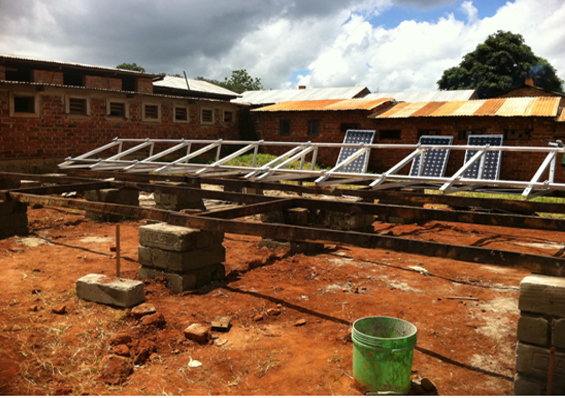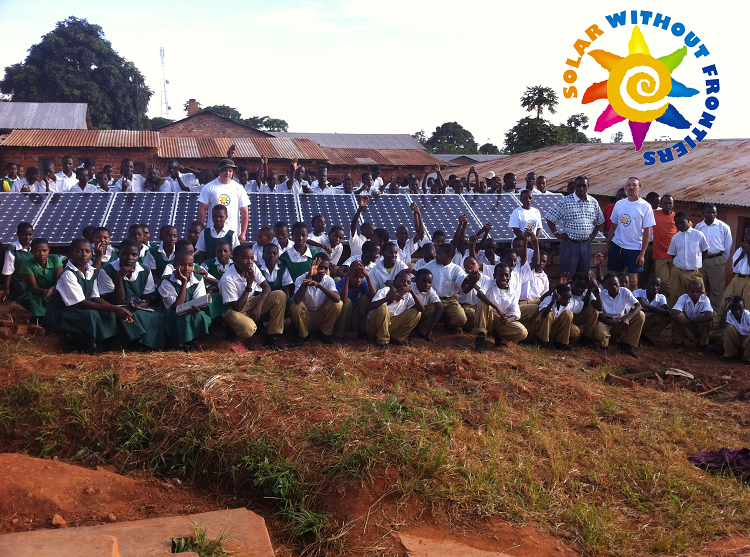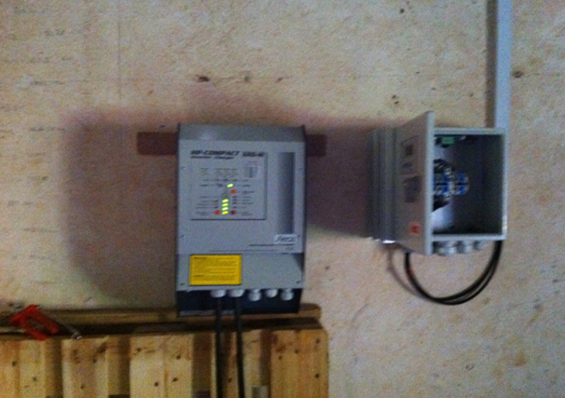Solar Without Frontiers (SWF), stand alone PV project at Hanga, Tanzania, March 2011.
Background:
In November 2010, I was asked by Solar Without Frontiers, a new Irish based charity to assist them with a project in Tanzania in February or March 2011. The maximum duration of the project would be 2 to 3 weeks. The aim of Solar Without Frontiers is to bring solar power to disadvantaged communities in Africa. Initially, their projects involved sending solar powered lights to villages where the only source of light at night is from wood fires or kerosene fuelled lanterns. Using wood and kerosene in small huts is unhealthy, expensive and unsustainable not to mention dangerous in terms of fire hazard. In addition, the quality of the light is poor, often leading to vision problems for people.
The project in Tanzania was much more ambitious in its scope and was to be carried out in partnership with the monks of Glenstal Abbey. They have long standing links with a Benedictine order in Southern Tanzania, near Songea, see http://hangaabbey.org/welcome/ for details.
One of the Glenstal brothers, John O’Callaghan approached Solar Without Frontiers last year to ask for advice and support for a solar project as a solution to the ongoing lack and instability of power at the educational facilities of the Abbey. John has been going every summer with a group of students from Glenstal to work there as volunteers and they have helped in setting up a computer room and education programmes in IT. This year, they raised in the region of €25,000 for the purchase of solar photovoltaic (PV) equipment which was delivered to Hanga in the last quarter of 2010. Earlier in the year, Solar Without Frontiers agreed that they would contribute to the project by travelling to Tanzania and installing the PV system at no cost to Glenstal and Hanga. The project installation would require 2 volunteers.
Execution:
The SWF volunteers, Fritz Raake a company director from Macroom and I travelled from Ireland to Dar Es Salaam in Tanzania on 5th March 2011 having personally raised the necessary funds for flights and Visas. The actual amount raised was close to €4,000 and the cost of the trip was €2,000. The additional funds raised are in the SWF bank account and will be used for the next project which is scheduled for later in 2011.
On 7th March 2011, we departed Dar Es Salaam for Hanga Abbey, a distance of 970km. We reached Hanga on the afternoon of 9th March 2011 and our first tasks were to assess if the equipment had arrived safely from Germany and to choose locations for the PV array, battery bank, charge controller and inverter. Unfortunately a metal mounting frame for the PV panels which was to have been installed by the time we reached Hanga had not been erected so we had to chose another suitable location. The alternative location is located within 10m of the battery bank location and is away from the areas where students congregate and is a very satisfactory site for the PV arrays (photo 1 below).
Photo 1: The proposed site for the PV arrays looking South.
The next task was to assemble the frames and mount the panels. Two of the local Brothers assisted us and the site was levelled with the help of the school children (photos 2,3 & 4).

Photo 2: Brother Augustine and Brother Fraternus assist in the frame assembly.

Photo 3: The children help to level the site for the frames.

Photo 4: Fritz and Tim complete the frames and panel mounting by the end of day 1
On a technical note, the PV panels were 24 volts, each with a peak output of 175 watts. The 20 panels were to be installed with 2 in series and 10 sets in parallel giving a 48 volt system and a current of approximately 63 amps with a max power output of 3.5kw.
Having completed the arrays, we next turned our attention to siting the battery bank. This was hard work as each of the 24 batteries weighs over 50kgs. The batteries are 2 volt with a capacity of 1200Ah. These maintenance free VRLA “Valve regulated lead acid ” batteries with successful dry fit technology range have been designed for ultra high cyclic applications therefore making them ideal for solar and wind power stations. As the system is 48 volt, the 24 batteries were connected in series (photo 5).

Photo 5: The 1200kg battery bank is put in place.
We now had to mount the charge controller and the inverter which weighs 40kg on a wall which had very poor fixing characteristics. The inverter cost over €5,000 and is the heart of the system as it converts the 48 volt direct current from the batteries into 220 volt alternating current which can be used to power normal household appliances and lights. We finally got both securely fixed and connected to the battery bank (photo 6).
Photo 6: The Stecca charge controller and inverter (left) are mounted and the green LEDs on the inverter indicate that the battery bank is correctly connected.
Our next priority was to get the PV arrays moved off the ground out of the way of animals and to reduce the amount of dust getting onto the glass of the panels. We engaged local builders who in very short order had the required pillars and frames assembled (photo 7).

Photo 7: The frames are ready to recieve the PV arrays. Panels are removed for safety.
Our next priority was to get the PV arrays moved off the ground out of the way of animals and to reduce the amount of dust getting onto the glass of the panels. We engaged local builders who in very short order had the required pillars and frames assembled (photo 7).

Photo 8: The junction box had to receive 20 input leads and 2 output leads. The suppliers should have sent a second box to place at the back of the first array but they didn’t and we were not in a position to source another!

Photo 9: Both arrays are earthed by connecting them to a thick copper rod.
Finally Brothers Augustine and Fraternus who are the Abbey’s electricians connected back to the inverter on the AC side so that by using a changeover switch the power could be switched over to the Solar PV system from the existing system which is unstable and relies on an old diesel generator and a hydro powered turbine which does not work in the dry season (photos 10 & 11).


Photo 11: The children and staff celebrate the successful completion of the project.
Conclusions and Recommendations:
The useful applications for Solar Power in Africa are almost limitless due to the abundance of sunlight and the lack of an effective reliable electrical grid even in the major cities of some countries. This was the first major project for SWF and was a success. However, some lessons have been learned for future project. The following are the major points in my opinion but the list is not exhaustive;
- A contingency length of DC cable should be included in the shipment from the supplier or the volunteers should bring it out. You will not be able to source the correct cable in most locations.
- Fused junction boxes should be brought out by the volunteers to allow best practice for the wiring of the PV panels.
- A correctly sized battery bank circuit breaker or fuse should be brought. The same applies to the PV array. This allows the isolation of each individual component of the system.
- An industrial grade multimeter is an essential piece of kit and should be brought out by the team.
- Consideration should be given to bringing out a pre wired AC fuse box which would allow the volunteers to provide a complete “plug and play” system.
- Another option is to bring out DC lighting and a number of laptops with DC chargers which would eliminate the need for a costly inverter.
- A correctly sized PV combiner, fused junction box should be included as part of the system.



